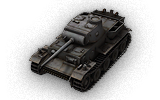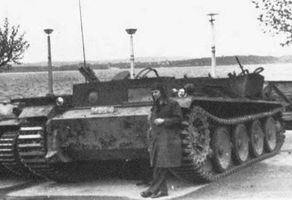VK 36.01 (H)
VK3601H (Stock)
| 935000 Preis |
| 1030 SPRobustheit |
| 41.38 / 45 Gewicht |
- Kommandant
- Richtschütze
- Fahrer
- Funker
- Ladeschütze
| 100/60/60Wannenpanzerung(Front/Seiten/Heck mm) |
| 80/60/60Turmpanzerung(Front/Seiten/Heck mm) |
| 400 PSMotorleistung |
| 50.5 km/hHöchstgeschwindigkeit vorwärts/rückwärts |
| 22 °/sDrehen/Wenden |
| 330 damage |
| 64 mmMittlere Durchschlagskraft |
| 9.21287320666925 Dauer für vollständiges Nachladen |
| 24 °/sGeschützrichtgeschwindigkeit |
| 240 mSichtweite |
| 500 mFunkreichweite |

The VK3601 H is a German tier 6 heavy tank
This tank was the first prototype of Germany's Pz.Kpfw. VI Tiger. It's a good combat tank, with good armor and excellent firepower once upgraded, however it is very prone to being ammo racked and having its crew members killed. Since the armour is not sloped at all, it is always reccomended to angle your armour in this tank.
With the patch 8.8 changes, the VK 36.01 (H) is now a true heavy tank with very high HP and a good selection of weapons allowing it to work well as a sniper or brawler.


Turm
| Stufe | Turm | Turmpanzerung (Front/Seiten/Heck mm) | Geschützrichtgeschwindigkeit (°/s) | Sichtweite (m) | Erfahrung | Gewicht (t) |
|---|---|---|---|---|---|---|
| V | VK 36.01 (H) | 80/60/60 | 24 | 240 | 0 | 7680 |
| Stufe | Geschütz | Mittlere Durchschlagskraft (mm) | Feuergeschwindigkeit | Streuung auf 100 m | Zielerfassung | Erfahrung | Gewicht (t) | |
|---|---|---|---|---|---|---|---|---|
| V | 10,5 cm Kw.K. L/28 | 64/104/53 | 330/330/410 | 6.51 | 0.55 | 2.3 | 0 | 2100 |
| VI | 7,5 cm Kw.K. 42 L/70 | 150/194/20 | 160/160/200 | 8.49 | 0.35 | 2.3 | 4600 | 1740 |
| VII | 7,5/5,5 cm Waffe 0725 | 157/221/53 | 160/160/410 | 8.87 | 0.34 | 2.3 | 9200 | 720 |
| Stufe | Turm | Turmpanzerung (Front/Seiten/Heck mm) | Geschützrichtgeschwindigkeit (°/s) | Sichtweite (m) | Erfahrung | Gewicht (t) |
|---|---|---|---|---|---|---|
| VI | Pz.Kpfw. VI H Ausf. H2 | 100/80/80 | 24 | 240 | 4415 | 8250 |
| Stufe | Geschütz | Mittlere Durchschlagskraft (mm) | Feuergeschwindigkeit | Streuung auf 100 m | Zielerfassung | Erfahrung | Gewicht (t) | |
|---|---|---|---|---|---|---|---|---|
| V | 10,5 cm Kw.K. L/28 | 64/104/53 | 330/330/410 | 6.51 | 0.55 | 2.3 | 0 | 2100 |
| VI | 7,5 cm Kw.K. 42 L/70 | 150/194/20 | 160/160/200 | 9.29 | 0.35 | 2.3 | 4600 | 1740 |
| VII | 8,8 cm Kw.K. 36 L/56 | 145/195/44 | 220/220/270 | 7.08 | 0.38 | 2.3 | 9500 | 2050 |
| VII | 7,5/5,5 cm Waffe 0725 | 157/221/53 | 160/160/410 | 9.75 | 0.34 | 2.3 | 9200 | 720 |

Motor
| Stufe | Motor | Motorleistung (PS) | Brandwahrscheinlichkeit bei Treffer | Erfahrung | Gewicht (t) |
|---|---|---|---|---|---|
| VI | Maybach HL 150 | 400 | 20 | 0 | 850 |
| VI | Maybach HL 174 | 500 | 20 | 6200 | 850 |

| Stufe | Fahrwerk | Maximalgewicht | Drehen/Wenden (°/s) | Erfahrung | Gewicht (t) |
|---|---|---|---|---|---|
| V | VK 36.01 (H) | 45 | 22 | 0 | 13000 |
| VI | VK 36.01 (H) verstärkte Ketten | 45 | 24 | 4935 | 13000 |

Funkgerät
| Stufe | Funkgerät | Funkreichweite (m) | Erfahrung | Gewicht (t) |
|---|---|---|---|---|
| III | FuG5_GER | 500 | 0 | 50 |
Compatible Equipment
Compatible Consumables
Player Opinion
Pros and Cons
Pros:
- Best armor of the four tier 6 German tanks.
- Can use the excellent 7,5/5,5 cm Waffe 0725, which has excellent accuracy, penetration and DPM.
- Can use the 8.8 cm KwK 36 L/56 which has very good damage.
- Spaced armor in the area of the engine.
- Excellent view range.
Cons:
- Somewhat slow traverse speed
- Relatively lightly armored lower glacis has the engine right behind it, very susceptible to fire and large amounts of damage when cresting a ridge or any other situation that exposes it.
- Very sluggish.
- lack of slopped armor hurts
Performance
The VK 36.01 (H) is a true heavy tank with good armor, very high HP, and very accurate guns. The 7,5/5,5 cm Waffe 0725 used to be the best gun choice but there's once again a choice to make over it and the 8.8 since the changes to it. The Waffe provides good penetration, high RoF, and accuracy making the tank a highly effective sniper. The mediocre alpha of 135 can be problematic as you're forced to expose yourself more often to keep the damage going. The 8.8 cm KwK 36 L/56 hits much harder while still having decent accuracy and RoF, but suffers from low penetration. While using this gun you will likely have to get a bit closer to take advantage of weak spots, and will very likely need APCR rounds on hand when against tier 8 tanks.
The VK 36.01 (H) has very good armor for its tier; this tank is capable of fighting more as a straight-up tank and feels more like a tank ready for production than a prototype. It can get into slug matches against lower tier opponents, it can support, it can snipe, it can do peek-a-boo from around corners, anything you want.
The VK 36.01 (H) doesn't have the best maneuverability and horrible turret traverse. While its top speed is only slightly slower than most medium tanks of its tier, its traverse speed is abysmal. The 8.8 engine changes have also given the tank sluggish acceleration, and simply cannot dream of reaching its top speed unless going downhill. This makes the VK 36.01 (H) much better suited to frontal attacks and slug matches. It follows the German doctrine of long range firepower, so one way to counter this tank is to isolate it and then engage it close up with multiple opponents. When the situation calls for it or when you see an opening in the enemy's defenses, take advantage of this opening and harass the enemy from the rear. This tactic is useful in the mid-late game, and has the advantage of surprise, as the enemy team will most likely not expect a "slow and lumbering pseudo-Tiger" to execute a flanking attack.
Early Research
- If you came from the VK 30.01 (H) you should have all the guns already unlocked except for the 8.8 cm KwK 36 L/56, and the Waffe can be used on the stock turret.
- Research the Waffe gun if you don't have it. If you really can't stand the 105, you can stop for the 7,5 cm KwK 42 L/70 first as it costs less than half the XP.
- Everything can be mounted on the stock suspension, so it can be researched at any point.
- Research the turret and engine in whichever order you prefer. The turret will add a whopping 190 HP to the tank, while the engine will help with the sluggish mobility.
- You can skip the 7,5 cm KwK 42 L/70 entirely if you got the Waffe first as it gets researched for free upon unlocking the Tiger.
- Go from there.
Historical Info
Only four VK 30.01 (H) prototypes were produced, two in March 1941 and two in October 1941. All were completed in 1942 by Henschel. In early 1942, one prototype VK 36.01 (H) was built, along with 5 prototype chassis. Originally, it was planned to mount the VK 30.01 (H) with a turret armed with the 75mm L/24 or 105mm L/28 gun, but none of the prototypes were actually fitted with turrets. The VK 36.01 (H) was to be armed with the 75mm KwK 42 L/70 (Gerat 725), the 88mm KwK 36 L/56 (mounted in the VK 45.01 (P)'s turret), or the 105mm L/20 or L/28 gun. But just as with the VK 30.01 (H), it was never armed with any weapon.
Both designs were completed as prototypes, but their further development was cancelled in 1942 in favor of the development of the VK 45.01 (P) that later became the Tiger 1. Turrets produced for both designs were never mounted and instead, in 1944, six VK 30.01 (H) turrets were used in permanent fortifications: Panzerstellung/Turmstellungs of the Atlantic and West Wall. Their running gear was later modified and used as a base for the Tiger and Panther's running gear.
In March 1941, two VK 30.01 (H)s were ready and from August 1941 to March 1942, were converted into 128mm Pak 40 L/61 gun carriers, the Selbstfahrlafette 12.8cm. Another two prototypes completed in October 1941 remained in Henschel's factory in Haustenbek and were used as recovery, training, and test vehicles. The VK 36.01 (H) prototypes were used as recovery and towing vehicles. The VK 30.01 (H) and VK 36.01 (H)'s design led to the subsequent development of Henschel's Tiger I.
Historical Gallery
Sources and External Links
| USA | VT14 • VT1 Heavy Tank • VIM6 • VIIT29 • VIIIT32 • VIIIT34 • VIIIT34 Independence • IXM103 • XT110E5 |
| UK | VChurchill I • VExcelsior • VIChurchill VII • VITOG II* • VIIBlack Prince • VIIICaernarvon • IXConqueror • XFV215b |
| Germany | IVPz.Kpfw. B2 740 (f) • IVDurchbruchswagen 2 • VVK 30.01 (H) • VIVK 36.01 (H) • VIITiger I • VIITiger (P) • VIITankenstein • VIIILöwe • VIIITiger II • VIIIVK 45.02 (P) Ausf. A • IXE 75 • IXVK 45.02 (P) Ausf. B • XE 100 • XMaus |
| USSR | VChurchill III • VKV-220 Beta-Test • VKV-1 • VIKV-1S • VIKV-2 • VIT-150 • VIIIS • VIIKV-3 • VIIIIS-3 • VIIIIS-6 • VIIIIS-6 Fearless • VIIIKV-5 • VIIIKV-4 • IXIS-8 • IXST-I • XIS-4 • XIS-7 |
| France | |
| China | |
| Japan | |
| Czechoslovakia | |
| Sweden |
